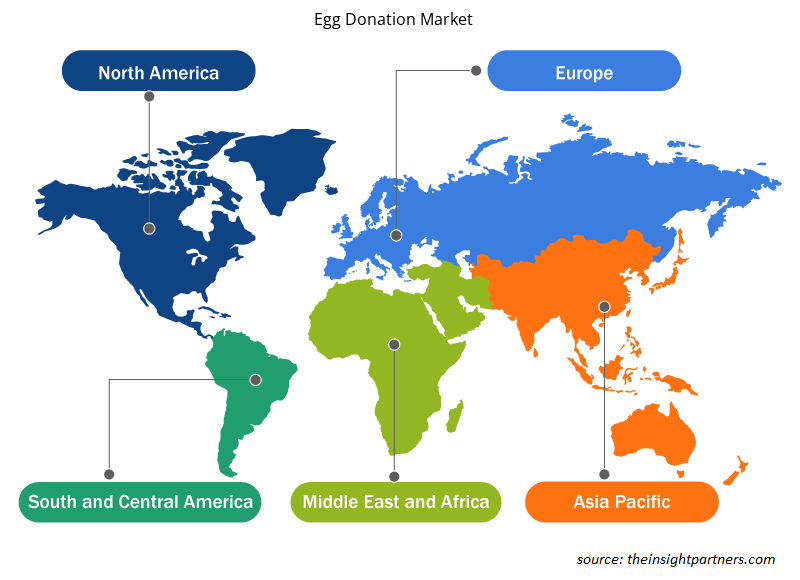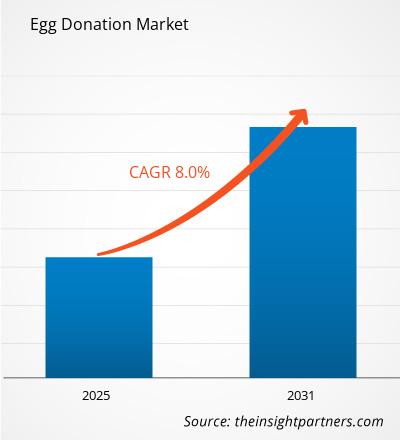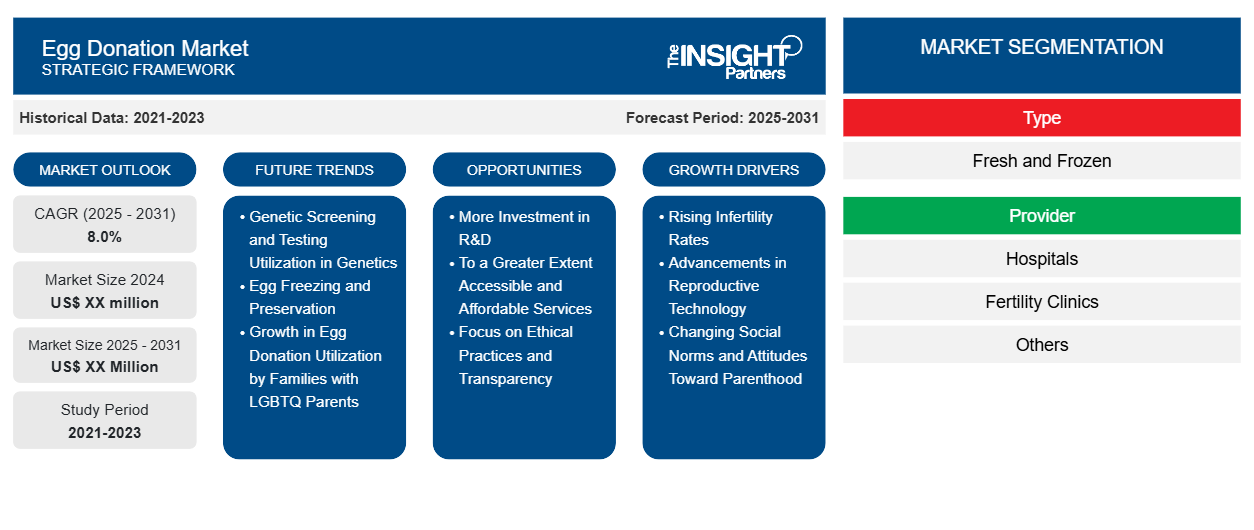预计 2023 年至 2031 年期间卵子捐赠市场的复合年增长率为 8.0%,市场规模将从 2023 年的 XX 百万美元扩大到 2031 年的 XX 百万美元。
报告按类型(新鲜和冷冻)细分。报告进一步根据适应症提供者(医院、生育诊所和其他)进行了分析。全球分析进一步细分为区域和主要国家。报告以美元为单位提供了上述分析和细分的价值。
报告目的
The Insight Partners 的《卵子捐赠市场》报告旨在描述当前形势和未来增长、主要驱动因素、挑战和机遇。这将为各种商业利益相关者提供见解,例如:
- 技术提供商/制造商:了解不断变化的市场动态并了解潜在的增长机会,从而能够做出明智的战略决策。
- 投资者:对市场增长率、市场财务预测以及整个价值链中存在的机会进行全面的趋势分析。
- 监管机构:监管市场政策和警察活动,旨在最大限度地减少滥用行为,维护投资者的信任和信心,维护市场的完整性和稳定性。
卵子捐赠市场细分
类型
- 新鲜和冷冻
提供者
- 医院
- 生育诊所
- 其他的
定制此报告以满足您的需求
您可以免费定制任何报告,包括本报告的部分内容、国家级分析、Excel 数据包,以及为初创企业和大学提供优惠和折扣
-
获取此报告的关键市场趋势。这个免费样品将包括数据分析,从市场趋势到估计和预测。
卵子捐赠市场的增长动力
- 不孕率上升:导致卵子捐赠市场增长的关键因素之一是全球不孕率上升。原因包括延迟生育、生活方式、医疗和环境因素。许多女性出于管理或教育目的或经济原因推迟生育,结果却在以后的生活中遇到了诸如卵子质量差和数量少等怀孕挑战。研究表明,这是克服不孕症的有效方法,因此对卵子捐赠者的需求也随之增加。
- 生殖技术的进步:体外受精 (IVF) 等辅助生殖技术进步为所有难以怀孕的女性打开了卵子捐赠的大门。卵子保存、胚胎冷冻和基因筛查方面的进步使生育治疗更加成功。随着结果的改善和卵子捐赠的可及性,现在它已成为所有准父母和考虑捐赠卵子的女性的有效选择。
- 社会规范和对父母身份的态度不断变化:越来越多的人被非传统家庭形式所接受,例如单身女性和同性伴侣以及年长的父母。所有这些都导致了对卵子捐赠服务的需求,因为人们需要生殖帮助来实现他们的父母愿望。
卵子捐赠市场未来趋势
- 遗传学中的基因筛查和检测应用:基因筛查是卵子捐赠市场的一个普遍趋势。诊所和生育中心进行基因检测以改善捐赠卵子的健康状况和质量。筛查遗传性疾病(也称为染色体异常)以抑制遗传疾病,从而为接受者带来更好的结果。这一趋势与对健康儿童的需求增加相一致;因此,它催生了“基因检测”或“基因筛查”卵子捐赠者,他们涉及更挑剔的客户。
- 卵子冷冻和保存:年轻女性的生活方式往往比个人生活更重要。她们冷冻卵子是为了将来继续生育。这为卵子捐赠的二级市场铺平了道路,因为由于某些原因无法生育的女性也可以冷冻卵子。她们可以继续自己组建家庭,忘记自己与年龄有关的生育问题。卵子冷冻正处于一个不断增长的轨迹中,随着这些技术变得越来越便宜,增长势必会增加,希望捐赠卵子的女性以及有兴趣使用卵子的女性将有更多机会。
- LGBTQ 父母家庭卵子捐赠利用率增长:卵子捐赠服务已见证了 LGBTQ 夫妇希望通过其生儿育女的社会接受度的提高。由于代孕对卵子捐赠的需求增加,这一趋势在同性男性夫妇和单身男性中可能会进一步增加。大多数同性恋夫妇求助于卵子捐赠和代孕服务,以便生下至少与父母一方有血缘关系的孩子。由于生育诊所需要满足 LGBTQ 社区的生殖需求,这一趋势打开了卵子捐赠市场的大门。
卵子捐赠市场机会
- 加大研发投入:卵子捐赠市场——需求使其成为一个有吸引力的研发投资领域,尤其是在基因检测、卵子保存和生育治疗方面。开发出更好的方法来改善卵子质量、提高 IVF 程序效率和降低风险并发症的公司和研究机构有可能彻底改变生育能力。投资最新技术和创新,以确保卵子捐赠服务的未来发展符合消费者的需求。
- 更大程度上提供可获得且负担得起的服务:卵子捐赠治疗费用昂贵;因此,这为更多客户能够获得这些服务提供了巨大的空间。单身女性和 LGBTQ 夫妇等不同人群的需求使负担能力和可获得性成为确保市场持续增长的两大因素。套餐和政府资助的生育计划等廉价模式可以增加所有人获得卵子捐赠的机会。
- 注重道德规范和透明度:这是企业可以采用的不同角度来区分其产品。随着公众对卵子捐赠的道德影响的认识不断提高,诊所可能会通过使捐赠过程在捐赠者和接受者的补偿和权利方面更加清晰和透明来吸引更多客户。这将使专利市场更好地关注道德,因为这将成为高度竞争中的强大差异化因素,并与客户建立信任。
卵子捐赠市场区域洞察
Insight Partners 的分析师已详细解释了预测期内影响卵子捐赠市场的区域趋势和因素。本节还讨论了北美、欧洲、亚太地区、中东和非洲以及南美和中美洲的卵子捐赠市场细分和地理位置。

- 获取卵子捐赠市场的区域特定数据
卵子捐赠市场报告范围
| 报告属性 | 细节 |
|---|---|
| 2023 年的市场规模 | XX 百万美元 |
| 2031 年市场规模 | XX 百万美元 |
| 全球复合年增长率(2023 - 2031) | 8.0% |
| 史料 | 2021-2022 |
| 预测期 | 2024-2031 |
| 涵盖的领域 |
按类型
|
| 覆盖地区和国家 |
北美
|
| 市场领导者和主要公司简介 |
|
卵子捐赠市场参与者密度:了解其对业务动态的影响
卵子捐赠市场正在快速增长,这得益于终端用户需求的不断增长,而这些需求又源于消费者偏好的不断变化、技术进步以及对产品优势的认识不断提高等因素。随着需求的增加,企业正在扩大其产品范围,进行创新以满足消费者的需求,并利用新兴趋势,从而进一步推动市场增长。
市场参与者密度是指在特定市场或行业内运营的企业或公司的分布情况。它表明在给定市场空间中,相对于其规模或总市场价值,有多少竞争对手(市场参与者)存在。
在卵子捐赠市场运营的主要公司有:
- 麦迪维斯全球
- 哥本哈根生育中心
- 生育协会
- Cryos国际
- 西班牙试管婴儿
免责声明:上面列出的公司没有按照任何特定顺序排列。

- 了解卵子捐赠市场顶级关键参与者概况
主要卖点
- 全面覆盖:报告全面涵盖了卵子捐赠市场的产品、服务、类型和最终用户的分析,提供了整体概况。
- 专家分析:报告基于对行业专家和分析师的深入了解而编写。
- 最新信息:该报告涵盖了最新信息和数据趋势,确保了其与业务的相关性。
- 定制选项:此报告可以定制以满足特定客户要求并恰当地适应业务策略。
因此,卵子捐赠市场研究报告可以帮助引领解读和了解行业情景和增长前景。尽管可能存在一些合理的担忧,但本报告的总体优势往往大于劣势。
- 历史分析(2 年)、基准年、预测(7 年)及复合年增长率
- PEST和SWOT分析
- 市场规模、价值/数量 - 全球、区域、国家
- 行业和竞争格局
- Excel 数据集
近期报告
客户评价
购买理由
- 明智的决策
- 了解市场动态
- 竞争分析
- 客户洞察
- 市场预测
- 风险规避
- 战略规划
- 投资论证
- 识别新兴市场
- 优化营销策略
- 提升运营效率
- 顺应监管趋势























 获取免费样品 - 卵子捐赠市场
获取免费样品 - 卵子捐赠市场